Durango notes used in other states
Sonora
On 27 December 1913, Pastor Rouaix wrote to Governor José María Maytorena of Sonora. Rouaix stated that because of the usefulness of making all the issues authorized by Constitutionalist governments and military authorities of obligatory circulation throughout the territory dominated by the Revolution, his government had decreed that the Estado de Sonora notes should be of forced circulation, and asked Maytorena to issue a reciprocal decree concerning the Asociación Durangueña and Estado de Durango notesADUR, Libro Copiador 267, Hacienda 11 July 1913 - 25 April 1914, p612; AGHES, tomo 2993 letter Pastor Rouaix, Durango to Maytorena, Hermosillo, 27 December 1913. The Sonoran government delayed replying, and it was only on 20 April 1914 that it was able to write that the matter had been addressed, and solved, by Carranza’s decree núm. 21 of 28 February making the notes of various states of forced circulation within the territory dominated by the Constitutionalists. This reply was acknowledged on 7 MayAGHES, tomo 2993 letter Gobernador Constitucional, Hermosillo to Gobernador Provisional, Durango, 20 April 1914: letter A. Gaxiola, Oficial Mayor, Durango to Gobernador Constitucional, Hermosillo, 7 May 1914.
Sinaloa
On 27 December 1913 Pastor Rouaix wrote to his counterpart in Sinaloa saying he had included its notes in those of forced circulation and suggested the latter do the same for the Asociación Durangueña and Estado de Durango notesADUR, Libro Copiador 267, Hacienda 11 July 1913 - 25 April 1914, p611.
On 4 November 1915 the governor of Sinaloa, Manuel Rodríguez Gutiérrez told his Tesorero General that General Diéguez had said that the Durango notes from 1914 and 1915 should circulate until 31 DecemberPeriódico Oficial, Sinaloa, Tomo VI, Núm. 104, 6 November 1915; Periódico Oficial, Sinaloa, Tomo VI, Núm. 105, 9 November 1915. On 22 December the Comandante Militar in Mazatlán, Mateo Muñoz, published a circular in which he stated that, as instructed by the Cuartel General of the Cuerpo de Operaciones del Noroeste, then in Guaymas, that as Arrieta’s second issue (Estado de Durango notes dated 31 December 1914) would circulate until new orders, people who refused them or increased their prices would be severely finedProgreso, Tomo I, Num. 28, 24 December 1915.
On 24 December a group of small businessmen complained to General Mateo Muñoz that the larger business establishments were refusing to accept payment from them in Durango notes. The military authorities (Generals Mateo Muñoz and Juan Carrasco and Coronel Miguel Orozco), summoned the owners of the larger establishments to reiterate that, until new orders, the notes were good. The arrival of General Manuel M. Diéguez would lead to a solution and in the meantime the government would fix a tariff for salesProgreso, Tomo I, Num. 28, 24 December 1915.
At the end of December 1915 Manuel M. Díeguez, Jefe de Operaciones en el Noroeste, from Esperanza, Sonora, told the Jefe de Hacienda in Mazatlán, Alejandro Duhagón, that since the circulation of Durango and Riveros notes was contrary to Carranza’s decree and another from his own Cuartel General (probably his notice of 14 October) he had decided to set a period of fifteen days from 1 January for holders to hand them in to the Jefatura and its dependencies in return for a certificate of deposit. Thereafter they would be considered null and voidPeriódico Oficial, Sinaloa, Tomo VII, Núm. 3, 6 January 1916.
Chihuahua
On 1 December the Tesorero General of Chihuahua, Sebastian Vargas, hijo prohibited the circulation of Arrieta notes. The governor of Durango, Emiliano G. Saravia, asked for clarificationADUR, Libro Copiador 278, Telegramas 13 August 1914 - 23 April 1915, p211 and was told it was Villa’s decision ADUR, Fondo Secretaría General de Gobierno (Siglo XX), Sección 6 Gobierno, Serie 6.7 Correspondencia, caja 7, nombre 37 telegram F. Avila, Chihuahua to Rouaix, 11 December 1914. Rouaix then appealed to VillaADUR, Libro Copiador 278, Telegramas 13 August 1914 - 23 April 1915, p231 telegram 12 December 1914 and Felicitos VillarrealADUR, Libro Copiador 278, Telegramas 13 August 1914 - 23 April 1915, p233, both in Mexico City, and Villa corrected the misinterpretationADUR, Fondo Secretaría General de Gobierno (Siglo XX), Sección 6 Gobierno, Serie 6.7 Correspondencia, caja 7, nombre 36 telegram 13 December 1914 and Saravia published a printed notice.
On 17 February 1915 Vargas told Durango that he has $140,000 in decomissioned notes that he wanted to be collectedADUR, Fondo Secretaría General de Gobierno, Sección Siglo XIX, Serie Correspondencia, Subserie Revolución, gaveta 6, nombre 88.Saravia said he would send someoneADUR, Fondo Secretaría General de Gobierno, Sección Siglo XIX, Serie Correspondencia, Subserie Revolución, gaveta 6, nombre 85; ADUR, Libro Copiador 278, Telegramas 13 August 1914 - 23 April 1915, p371. A week later, Vargas had $150,000ADUR, Fondo Secretaría General de Gobierno, Sección Siglo XIX, Serie Correspondencia, Subserie Revolución, gaveta 6, nombre 83 letter Vargas to governor, Durango, 23 February 1915. Saravia again said he would send someoneADUR, Libro Copiador 278, Telegramas 13 August 1914 - 23 April 1915, p371. On 17 March Vargas asked for someone to collect $170,000ADUR, Fondo Secretaria General de Gobierno (Siglo XX), Sección 6 Gobierno, Serie 6.7 Correspondencia, caja 7, nombre 57. On 19 March Jesús Hernández was commissioned to collect $200,000 fom the Departamento de Hacienda in Chihuahua to exchange the Arrieta issuesADUR, Libro Copiador 298, Hacienda 23 February 1915 - 26 May 1915, p140 and to pick up $160,000 in Durango bonos from VargasADUR, Libro Copiador 298, Hacienda 23 February 1915 - 26 May 1915, p141. Hernández was accompanied by Antonio NavarreteADUR, Libro Copiador 278, Telegramas 13 August 1914 - 23 April 1915, p420).
On 7 May Saravia told Vargas that he could send the $32,602 that he had in mutilated notes and which would be exchangedADUR, Libro Copiador 303, Telegramas 23 April 1915 - 10 April 1916, p35. A Capitán 1o Francisco Cena took the notes in two packetsADUR, Fondo Secretaría General de Gobierno, Sección Siglo XIX, Serie Correspondencia, Subserie Revolución, gaveta 7, nombre 3 and ADUR, Libro Copiador 298, Hacienda 23 February 1915 - 26 May 1915, p423. Among them the Dirección General de Rentas found $345.00 in Series F Arrieta notes and $6.50 in counterfeit Estado de Durango notesADUR, Fondo Secretaría General de Gobierno, Sección Siglo XIX, Serie Correspondencia, Subserie Revolución, gaveta 6, nombre 88. Durango tried to get a credit from ChihuahuaADUR, Libro Copiador 298, Hacienda 23 February 1915 - 26 May 1915, p456, but were given short shift and finally wrote the sum offADUR, Fondo Secretaría General de Gobierno, Sección Siglo XIX, Serie Correspondencia, Subserie Revolución, gaveta 6, nombre 88.
On 11 May 1915 the Tesorería General in Chihuahua sent $2,000 in 25c and 50c (sábanas) notes to Parral so that they could replace the badly deteriorated Estado de Durango notesAMP, Gobierno, Gobierno del Estado, Correspondencia, caja 21, exp 3.
On 7 July Vargas sent Capitán Cena with a further $2,525 in notesADUR, (Durango, Fondo Secretaría General de Gobierno, Sección Siglo XIX, Serie Correspondencia, Subserie Revolución, gaveta 7, nombre 15. When the Dirección General de Rentas checked it they found it contained $2,524, including $150 in Series F notesADUR, Fondo Secretaría General de Gobierno, Sección Siglo XIX, Serie Correspondencia, Subserie Revolución, gaveta 6, nombre 83 and ADUR, Libro Copiador 304, Hacienda 20 May 1915 - 1 March 1916, p263.
Coahuila
In Torreón the military authorities, in listing the issue of forced circulation, originally omitted the Durango notes but after pressure from the Durango government, on 18 October 1913 issued a circular naming the bonos al portadorEl Demócrata, Segunda Época, Tomo II, Núm. 22, 26 October 1913.
Nuevo León
Apparently there were serious difficulties in trading with Monterrey so in June 1914 it was reported that the governor, during a stay in Monterrey, persuaded Pablo González and Antonio Villarreal, the governor of Nuevo León, to declare the Durango notes, authorised by Carranza, to be of forced circulationEl Demócrata, Segunda Época, Tomo II, Núm.120, 26 June 1914. They were included in a decree of Pablo González in Monterrey, on 18 JuneEl Demócrata, Segunda Época, Tomo II, Núm.122, 1 July 1914.
They might have been unfrequent. In March 1915 the Compañía de Tranvías, Luz y Fuerza Motriz de Monterrey took in a $1 Estado de Durango, number 33570, where the value had been changed from $1 to $5ANL, Correspondencia de Alcaldes: Monterrey, caja 131 letter Presidente Municipal, to Secretario de Gobierno, 20 March 1915.
On 4 July 1915 General Luis Caballero told his Oficial Mayor, Gonzalo Castro, that in accordance with Carranza’s decree Durango notes were of forced circulation until 30 September Periódico Oficial del Estado de Tamaulipas, Tomo XL, Núm. 38, 7 July 1915.
Tamaulipas
In July 1914 travellers from Tampico and Ciudad Victoria were reporting that Durango notes (and Villista notes) were not yet accepted there. Among the Spanish who dominated commerce in Tampico were refugees expelled by Villa from the Comarca LaguneraEl Demócrata, Segunda Época, Tomo II, Núm.123, 3 July 1914.
On 4 July 1915 General Luis Caballero told his Oficial Mayor, Gonzalo Castro, that in accordance with Carranza’s decree Durango notes were of forced circulation until 30 SeptemberPeriódico Oficial del Estado de Tamaulipas, Tomo XL, Núm. 38, 7 July 1915. Despite this in July businesses in Matamoros continued to refuse the notes alleging that they were did not have sufficient backing and that the public did not accept themLa Prensa, 19 July 1915. On 9 July Francisco González Rodríguez, at Brownsville, Texas, reported great difficulty with the acceptance of Durango notes and asked whether they were forcedABarragán, caja II, exp. 9. f. 26 telegram González to Carranza, Veracruz, 9 July 1915. By September, as the Jefatura de Hacienda had said that the notes would cease to be legal tender from 1 September businesses were refusing them, so the Jefatura stated that, by order of Carranza, they would continue to be of forced circulation until 30 SeptemberLa Prensa, 3 September 1915.
San Luis Potosí
On 14 April 1915 San Luis Potosí included in a list of notes of forced circulation the 50c and $1 notes issued in October and December 1914 and signed by Emiliano G. Saravia, J. M. Olagaray and A. Gaxiola D.ADUR, Fondo Secretaría General de Gobierno, Sección Siglo XIX, Serie Correspondencia, Subserie Revolución, gaveta 6, nombre 88.
A $5 August 1914 note is known revalidated by the Prefectura Regional with a blue circular (43.5mm) rubber stamp with the legend ‘PREFECTURA REGIONAL DEL PARTIDO DE LA CAPITAL - SAN LUIS POTOSI’ and an eagle in the centre, together with a three-line inscription ‘Este Billete es de circulacion forzosa. S.L.P.....1915 E.P.R’ and the stamped signature of J. Rangel.
Hidalgo
On 20 February 1915 the government threatened to punish businesses that continued to refuse to accept Durango notes, even though Carranza had decreed that they were of forced circulation until 31 MarchPeriódico Oficial, Hidalgo, Tomo LXVIII, Núm. 16, 28 February 1915 and on 12 March repeated the message "for the last time"Periódico Oficial, Hidalgo, Tomo LXVIII, Núm. 20, 12 March 1915.
Zacatecas
The bonos were apparently immediately accepted in Zacatecas, at a 2% discountEl Demócrata, Segunda Época, Tomo II, Núm. 6, 31 August 1913.
On 12 November 1913 Pastor Rouaix wrote to L. J. Zalce, his counterpart in Sombrerete, Zacatecas, suggesting that the Asociación Durangueña notes and bank-on-bank cheques should be allowed to circulate in that stateADUR, Libro Copiador 267, Hacienda 11 July 1913 - 25 April 1914, p405. Zalce agreed on 27 NovemberADUR, Libro Copiador 267, Hacienda 11 July 1913 - 25 April 1914, p463. This was reported in early DecemberEl Demócrata, Segunda Época, Tomo II, Núm. 34, 7 December 1913. This, again, will have been superseded by Carranza’s decree of 28 February 1914.
In November 1914 the Jefatura de Hacienda included the August 1914 $5 Series E and $50 Series among the notes of forced circulationPeriódico Oficial, Tomo LXVIII, Núm. 5, 13 December 1914.
On 22 January 1915 the Jefe de Hacienda, Teodoro Carrillo, responding to reports that businesses were refusing Durango notes, reminded people that they were of forced circulationSiglo XX, Zacatecas, Núm. 59, 22 January 1915 and the government distributed copies of the circular to jefes políticosAMZac, Jefatura Política, caja 13, exp. 23, folio 38, caja 14, exp. 4, folios 4 and 14.
On 16 February 1915 the government of Zacatecas wrote to Durango to ask, as there was a large number of bonos in a poor state circulating with difficulty, whether the latter could send $100,000 of its latest issue, in order to exchange themADUR, Fondo Secretaría General de Gobierno, Sección Siglo XIX, Serie Correspondencia, Subserie Revolución, gaveta 6, nombre 88. Saravia replied by sending Jesús Hernández to explain how to distinguish counterfeitsADUR, Fondo Secretaría General de Gobierno, Sección Siglo XIX, Serie Correspondencia, Subserie Revolución, gaveta 6, nombre 85; ADUR, Libro Copiador 278, Telegramas 13 August 1914 - 23 April 1915, p370 but Teodoro Carrillo, the Jefe de Hacienda in Zacatecas, felt that because of their condition, the notes needed to be exchanged and suggested sending $25,000 to $30,000 a monthADUR, Fondo Secretaría General de Gobierno, Sección Siglo XIX, Serie Correspondencia, Subserie Revolución, gaveta 6, nombre 88 letter T. Carrillo, Zacatecas, to Saravia, Durango, 2 March 1915. Durango could not manage that and suggesting sending the notes to Durango to exchange themADUR, Libro Copiador 298, Hacienda 23 February 1915 - 26 May 1915, p113 letter Gaxiola to Carrillo, 18 March 1915. Carrillo wrote again on 23 February 1915ADUR, Fondo Secretaría General de Gobierno, Sección Siglo XIX, Serie Correspondencia, Subserie Revolución, gaveta 6, nombre 83. On 24 February Jesús Hernández was again commissioned to deal with the matterADUR, Libro Copiador 298, Hacienda 23 February 1915 - 26 May 1915, p7. On 6 March Hernández reported that Carrillo had issued a notice punishing those who refused Durango notes. He also reviewed the holding of notesADUR, Fondo Secretaría General de Gobierno, Sección Siglo XIX, Serie Correspondencia, Subserie Revolución, gaveta 6, nombre 88,
| in Jefatura de Hacienda |
in Dirección de Rentas |
|
| emisión de diciembre de 1913 | $4,497.50 | $449.70 |
| autorizada por el Primer Jefe | 9,145.00 | 683.50 |
On 8 March Saravia told the Jefe de Hacienda in Zacatecas that he was happy to redeem his notes but since he has insufficient resources to do it all at once he asked him to send them in portions over timeADUR, Libro Copiador 298, Hacienda 23 February 1915 - 26 May 1915, p73.
On 3 April the Presidente Municipal of Vetagrande reported that his employees had been paid partly with Estado de Durango notes that businesses were refusing to accept. He remitted $31 which he asked to be changedAMZac, Jefatura Política, caja 14, exp. 11, folio 29.
On 17 April Carrillo asked Durango how much could it send to exchange its notesADUR, Fondo Secretaría General de Gobierno, Sección Siglo XIX, Serie Correspondencia, Subserie Revolución, gaveta 6, nombre 88 and by 24 April it was agreed that Rafael Prieto, the cajero in Carrillo’s office would take $68,182.60 in Durango notes to be exchangedibid.. However, on 30 Abril Gaxiola had agreed to $30,000ADUR, Libro Copiador 298, Hacienda 23 February 1915 - 26 May 1915, p369. The notes were “cuadrados” and early Arrieta issues.
Aguascalientes
On 29 May Aguascalientes reported that its public offices had $47,000 in Durango notes and that there was probably the same amount held by individualsADUR, Fondo Secretaría General de Gobierno, Sección Siglo XIX, Serie Correspondencia, Subserie Revolución, gaveta 7, nombre 3.
Guanajuato
The Administración General de Rentas included the notes issued with Carranza's authorisation in January 1914 in its list of acceptable notes on 1 September 1914El Observador, Guanajuato, Año XI, Núm. 883, 7 September 1914. In December the Conventionist government listed Durango issues as among those of forced circulation (as well as warning against counterfeit notes)Periódico Oficial, Guanajuato, Tomo LXVIII, Núm. 2, 3 December 1914. They were included in a more detailed list later in the monthPeriódico Oficial, Guanajuato, Tomo LXVIII, Núm. 6, 17 December 1914.
Dick Long in his November 1974 auction has a $5, dated August 1914, with a resello for León, Guanajuato[image needed].
Jalisco
In early November 1914 it was reported that the notes of Durango would be redeemed and exchanged for new Constitutional issuesBoletín Militar, Tomo II, Núm. 99, 8 November 1914 but in December it was announced that they (and Obregón notes) were still good until the government redeemed them and anyone refusing them would be punished (despite the abuses of the tram operators))Boletín Militar, Tomo III, Núm. 122, 5 December 1914.
On 25 February 1915 Saravia sent the governor of Jalisco two examples of bonos. The one was from Durango, and like all the Arrieta’s notes, except for Series F, was good and of forced circulation. The other was printed in Guadalajara for Arrieta, who still appears as Governor even though he was deposed by the Conventionists on 27 September, and was not.
The differences between the two issues were obvious, and Saravia asked that the latter, which were numerous in Jalisco, be prohibitedADUR, Libro Copiador 298, Hacienda 23 February 1915 - 26 May 1915, p16. On 9 March J.C. Medina replied that according to a decree issued in Guadalajara only the notes issued in January 1914 were of forced circulationADUR, Fondo Secretaría General de Gobierno, Sección Siglo XIX, Serie Correspondencia, Subserie Revolución, gaveta 6, nombre 88. On 22 March Ramón Puente from Guadalajara asked if notes of Mariano (sic) Arrieta dated 15 August 1914 were being exchanged ADUR, Fondo Secretaria General de Gobierno (Siglo XX), Sección 6 Gobierno, Serie 6.7 Correspondencia, caja 7, nombre 57 and ADUR, Fondo Secretaria General de Gobierno (Siglo XX), Sección 6 Gobierno, Serie 6.7 Correspondencia, caja 7, nombre 57 and was told that the Series A and E notes were being accepted in payment of taxes in order to amortise themADUR, Libro Copiador 278, Telegramas 13 August 1914 - 23 April 1915, p430.
On 13 April 1915 a newspaper article on the legitimacy of various issues stated that the notes of the Estado de Durango were of forced circulation in that state but that, according to an order of the General en Jefe del Ejército de las Operaciones de la Convención, thet were not of legal and forced circulationLa República, Núm. 63, 13 April 1915.
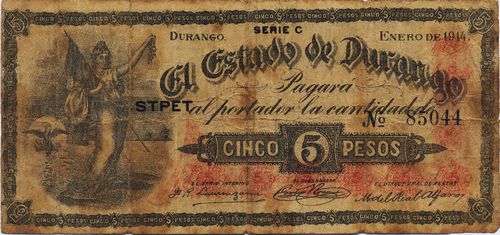
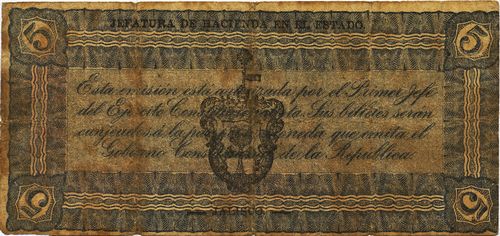 M1491b $5 Estado de Durango
M1491b $5 Estado de Durango
This resello of the Jefatura de Hacienda with the state's coat-of-arms is slightly different from the resello used on the sábanas and dos caritas and could be either a Villista or a Constitucionalista overprint.
On 22 June 1915, in reply to a query from the Presidente Municipal of Tequila, Director General J. O. González, said that Estado de Durango notes were not of forced circulation but could be exchanged in time, if they had been revalidated by the Jefatura de HaciendaAHTeq, Sección Presidencia, Serié Correspondencia, Año 1915, caja 1, exp. 2. When José Manuel Medina handed over the municipal funds to Rogelio Palomera Meza on 31 July, there was $35 in Obregón. $11 in Riveros, $4 in Estado de Durango and only $2.09 in note of forced circulationAHTeq, Sección Presidencia, Serié Correspondencia, Año 1915, caja 1, exp. 4.
Michoacán
On 5 October 1914 the Tesorero Municipal of Morelia wrote to the Presidente Municipal about the confusion whereby some thought that all notes were of forced circulation whilst others refused to accept them. The Administración del Timbre were refusing Huertista notes from Monterrey, Mazatlán, Guaymas and SaltilloDid this just refer to an instruction received from Mexico City or were any of these issues actually in use in Morelia? and those from the Estado de Durango. He asked for instructionsAMMor, caja 29, exp. 114.
Guerrero
On 18 March 1915 General Crispín Galeana, the comandante militar in Tlapa, issued a notice that the public should accept all notes with confidence. Villista and Durango notes would be of forced circulation until the government exchanged them for a new issueAHMTla, caja 35, Presidencia, exp. 2, 19 March 1915.
Oaxaca
By December 1914 notes issued by the Estado de Durango which had not been revalidated by the Secretaría de Hacienda were causing problems. The local Jefe de Hacienda, José Zorrilla, on 19 December asked Carranza’s Secretaría de Hacienda whether they should still be accepted and on the same day received the reply that they could be acceptedAO, Fondo Gobierno Siglo XX, sección Secretaría del Despacho, serie Leyes y Decretos, caja 4902, exp. 3, 1914-1915. What revalidation was Zorrilla referring to?
Mexico City
Revalidado
The Convention also included Durango issues in the notes that they accepted as legal tender. However, on 17 March 1915 Conventionist President Roque Gonzalez Garza, amended his previous decrees so as to read that the notes of Durango were of legal tender only when revalidated by the Conventionist government with the legend ‘REVALIDADO Por decreto de 17 de diciembre de 1914’. This change was made because of the number of counterfeits and the fact that the government in Mexico City now had a revalidating machine. The Durango notes known with this revalidation are Carranza’s 50c, $1 and $5 of January 1914 and Arrieta’s $5, $5 and $50see CNBanxico #4007 of August 1914.
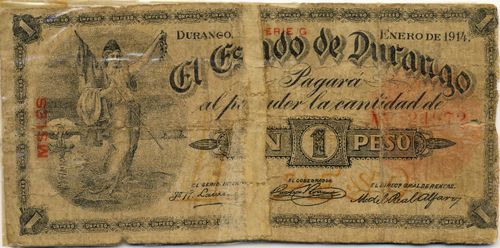
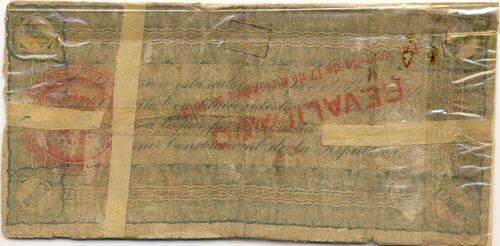 M1489b $1 Estado de Durango 'REVALIDADO'
M1489b $1 Estado de Durango 'REVALIDADO'
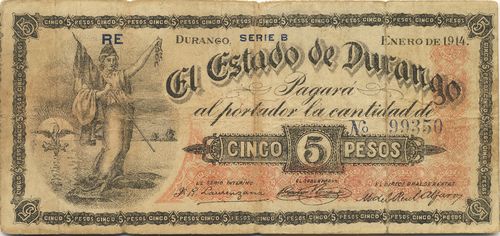
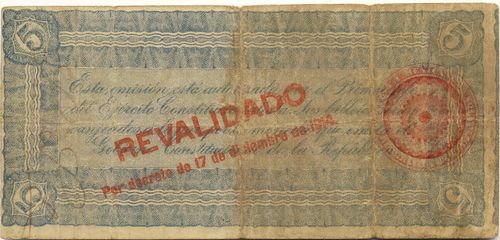 M1492a $5 Estado de Durango 'REVALIDADO'
M1492a $5 Estado de Durango 'REVALIDADO'
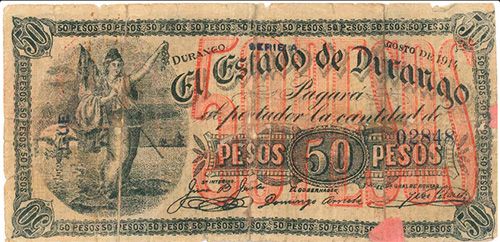
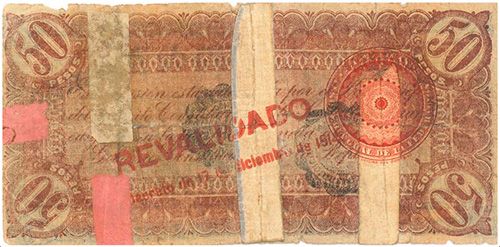 M1496b $50 Estado de Durango 'REVALIDADO'
M1496b $50 Estado de Durango 'REVALIDADO'
Estado de México
On 29 July 1915 the Administradores de Rentas of the state were told that Durango notes revalidated in Mexico City (as above) continued being of forced circulationAMTol, Presidencia, caja 203, exp. 12.
